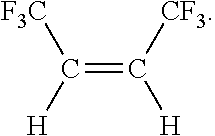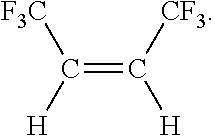Process for the production of fluorinated alkenes
a technology of fluorinated alkenes and process, which is applied in the field of process for the preparation of fluorinated alkenes, can solve the problems of new set of problems, toxicity, boiling point and other critical properties required to meet the application, and process giving a mixture of cis- and trans-isomers is likewise undesirabl
- Summary
- Abstract
- Description
- Claims
- Application Information
AI Technical Summary
Benefits of technology
Problems solved by technology
Method used
Image
Examples
example 1
Preparation of CCl3CF2CHFCF3
[0049]A 0.5 inch (12.7 mm) by 40 inch (101.6 cm) plug flow reactor that is packed with Helipack Monel support is heated to 290° C. A 50 / 50 (molar %) mixture of hexafluoro-propene and chloroform is fed into the reactor at about 1.5 g / min. The reactor pressure is maintained at 100 psig. The effluent from the reactor is fed into a distillation column and the unreacted reagents removed by distillation and recycled. The product CCl3CF2CHFCF3 is used in the next reaction.
example 2
Preparation of CF3CF2CHFCF3 by Liquid Phase Fluorination
[0050]The liquid phase fluorination of CCl3CF2CHFCF3 is conducted in the presence of SbCl5. About 600 g of SbCl5 are added to a liquid phase reactor. The reactor is heated to from 80° C. to 90° C. and the HF feed is started. After about 0.1 lbs (4.54 kg) of HF are added, the CCl3CF2CHFCF3 feed is started. The corresponding feeds for the HF and organic are about 0.05 lb / h (2.27 kg / hr) and 0.04 lb / h (1.8 kg / hr) respectively. The average pressure for the system during the reaction is about 100 psig (689.5 kPa).
example 3
[0051]A Hastelloy-C reactor is charged with 50 cc of a Ni—Cu—Cr catalyst and pretreated with hydrogen gas for two hours at 400° C. While maintaining a hydrogen atmosphere, the organic compound, CF3CF2CHFCF3 is vaporized into the reactor such that the H2 to organic molar ratio is at least 2:1. The olefin products are collected in a cold trap, and then recycled thru the reactor system in order to complete the conversion of the organic compound into the butyne product.
PUM
| Property | Measurement | Unit |
|---|---|---|
| boiling points | aaaaa | aaaaa |
| boiling points | aaaaa | aaaaa |
| pressure | aaaaa | aaaaa |
Abstract
Description
Claims
Application Information
 Login to View More
Login to View More - R&D
- Intellectual Property
- Life Sciences
- Materials
- Tech Scout
- Unparalleled Data Quality
- Higher Quality Content
- 60% Fewer Hallucinations
Browse by: Latest US Patents, China's latest patents, Technical Efficacy Thesaurus, Application Domain, Technology Topic, Popular Technical Reports.
© 2025 PatSnap. All rights reserved.Legal|Privacy policy|Modern Slavery Act Transparency Statement|Sitemap|About US| Contact US: help@patsnap.com


